[ad_1]
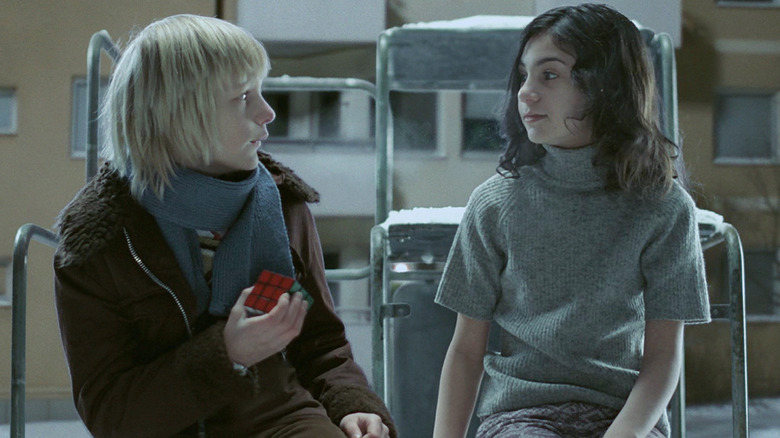
What happens if you fall in love with a vampire? That was the big question in 2008 when two movies tried to answer the same question with wildly different results. The biggest, of course, was “Twilight,” the tepid teen vampire romance adapted from the novel by Stephanie Meyer, who did away with some of the gnarlier elements of bloodsucker lore and had hers twinkling in the sunshine instead of their usual scorching fate.
Lesser known but far better received by horror fans and critics was Tomas Alfredson’s bleak and tender “Let the Right One In.” Adapting the screenplay from his own novel, author John Ajvide Lindqvist stated that his intention was to ditch any romanticized notions and imagine what life would really be like for a vampire stuck in the body of a 12-year-old child (via Ain’t it Cool). Needless to say, it is much less glossy than Robert Pattinson and the Cullens wafting around looking beautiful, and the grimness of the situation extends to the poor kid who is unlucky enough to become the vampire’s boyfriend/familiar.
Alfredson’s romantic horror is a real slow-burner that takes its time to establish the strange relationship between its two protagonists, punctuated by bursts of brutal yet matter-of-fact violence. Everywhere looks unreal in the snow, but the setting of a dreary modernist Swedish housing estate looks particularly otherworldly, giving the story the atmosphere of a dark fairy tale. Unlike “Twilight,” “Let the Right One In” also revels in the classic vampire tropes that have served cinema well in the century since “Nosferatu” was released; sunlight proves reassuringly and spectacularly fatal. It all finishes on an ambiguous note and one that doesn’t necessarily promise a happy ending. But what does the future hold for our young sweethearts?
So What Happens In Let The Right One In Again?
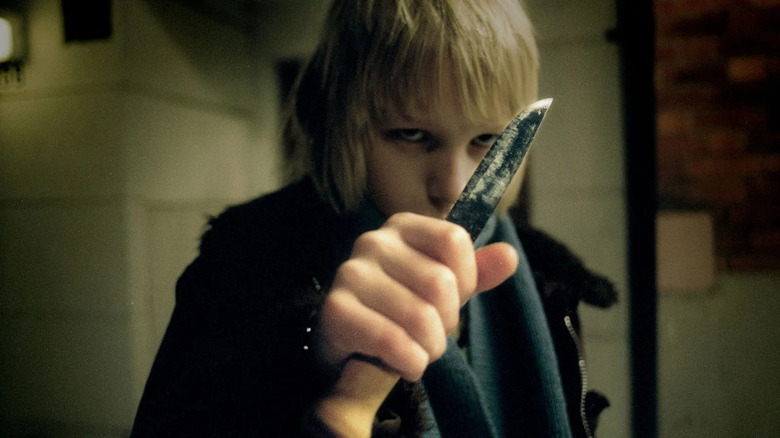
“Let the Right One In” is set on the Blackeburg estate in Stockholm in 1982, where Oskar (Kåre Hedebrant) is a lonely 12-year-old boy living with his single mother. At school he is tormented by bullies and fantasizes about making them “squeal like a pig” in revenge with his pocket knife. Meanwhile, some new people move into the apartment next door; a middle-aged man named Håkan (Henrik Dahl) and Eli (Lina Leandersson), a mysterious girl around Oskar’s age. When Oskar first meets Eli by the playset outside their building, she tells him they can’t be friends and we soon get some indication of why.
Eli is a vampire and relies on Håkan to source fresh blood for her. His first bungled attempt, waylaying a passerby and bleeding him like a pig, is interrupted by dog walkers. Eli goes hungry that night which prompts her to take matters into her own hands, attacking and killing a denizen of the local pub, Jocke (Mikael Rahm).
Despite her earlier warning, Eli and Oskar start a tentative friendship, communicating in morse code through their bedroom wall. He thinks she’s poor because she wanders around with no coat in the snow and smells funny, and she encourages him to stand up to the bullies at school.
Eli finds herself on her own in the world when Håkan gets caught trying to harvest a teenager for his blood and pours acid on his face to prevent the cops from identifying him. As a last act of devotion, he offers himself as an emergency ration pack when she visits him in the hospital. With her guardian and personal shopper gone and her stomach rumbling, who can Eli turn to next?
What Does The Title Mean?
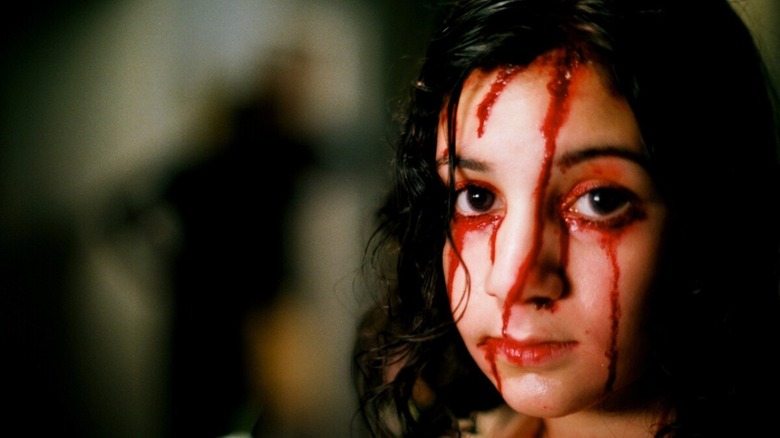
“Let the Right One In” takes its title from the Morrissey song “Let the Right One Slip In,” which implores the listener to put past heartbreak behind them in the trepidatious hope that the right one will come along someday. Given Oskar’s lonely childhood and troubles at school, that would seem to be good advice for him in his budding romance with Eli. However, since she’s a vampire, it also takes on far more sinister connotations related to folkloric traditions of keeping evil creatures at bay.
Legends of vampires have been around in European folklore since medieval times, and over the centuries they have acquired all the classic strengths and weaknesses that we all know today. “Let the Right One In” refers to one in particular: A vampire requires an invite to enter your home and, if you do so, they can come and go whenever they feel like it (via Fiction Horizon).
The threshold of the home is a powerful symbol of safety and protection, so it is little wonder that it is the focus of many superstitions. It wasn’t just vampires who threatened unwanted entry in the old days: ghosts, witches, and demons also needed keeping out. In Mesopotamia, evil demons could be invoked to protect the home from other demons with statuettes placed strategically by windows and doors, while in Europe people placed dead cats in their walls to ward off evil spirits. Even nowadays in New Orleans voodoo, you can buy red brick dust to scatter along the threshold to protect the home.
The title of “Let the Right One In” carries a cautionary dual meaning. When it comes to vampires, you would definitely be foolish to invite one into your home, and that no doubt also applies to the heart (as we see in the sad case of Håkan).
Håkan
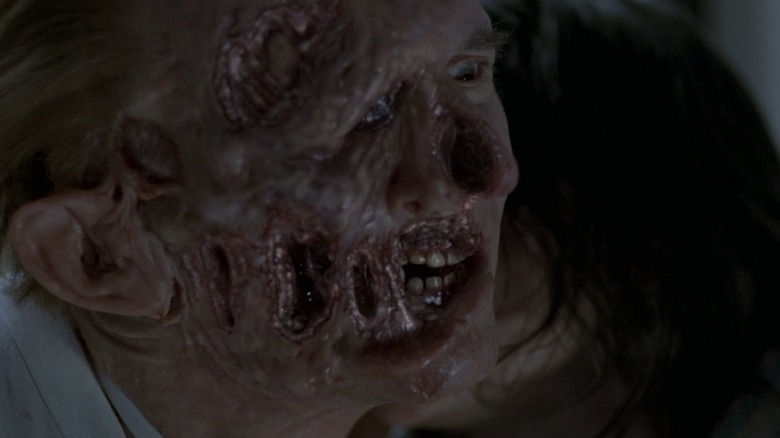
We get little to nothing of Eli and Håkan’s backstory in “Let the Right One In,” but we can fill in the gaps. When they move in next door to Oskar and his mum, it is under the cover of darkness and they have very few belongings with them. The first thing Håkan does is cover the windows with cardboard. They pass themselves off as father and daughter, but Håkan’s role is more complex; he’s a combination of parent, guardian, and familiar, held in Eli’s thrall like Renfield in “Dracula.” In one scene he tells Eli off for venturing out to kill Jocke, but it’s clear that she is the boss in this relationship.
Håkan is growing old and weary, and he’s losing his touch when it comes to sourcing blood for Eli. His existence is a desperately lonely one; moving around from town to town to keep a low profile, unable to fit in or make friends, always shacked up in some temporary accommodation until their cover is blown and it’s time to go. His whole life revolves around murdering people to keep Eli sated, knowing that if he can’t provide she will eventually become hungry enough to feed on him. When it comes to the crunch, he’s so devoted that he offers his throat as a vital snack to keep her going.
Eli inhabits the body of a 12-year-old and mentions to Oskar that she has been that age for a long time. Håkan is now middle-aged, but how old was he when he was first bewitched by Eli? Oskar’s age, perhaps? It doesn’t bode well for Oskar’s future, especially as Eli pays more interest in him after Håkan’s horrible death; notably, the boy is regularly framed or reflected in windows, mirroring how we often see the older man.
Eli’s Gender And How She Feels About Oskar
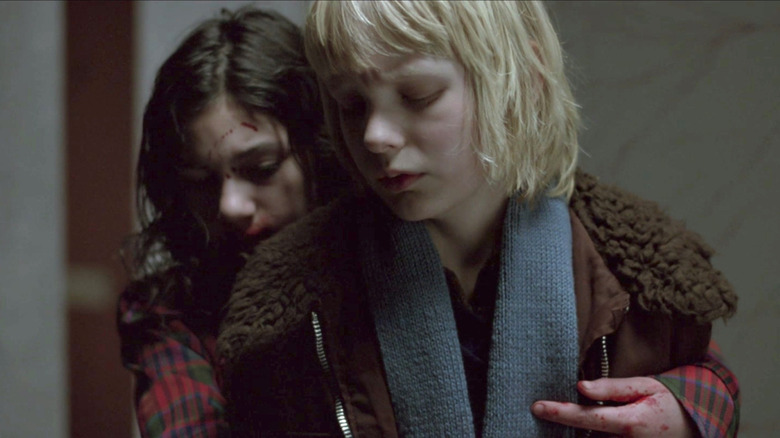
Eli starts dropping Oskar hints about her gender early on in their relationship. “I’m not a girl,” she says at one point, but the movie frames it as a reference to what the viewer already knows: She’s a vampire. Oskar is not phased by these hints and likes her just the way she is, even coming to terms with the fact she needs human blood to survive.
Later, when Oskar catches a glimpse at her changing, we get the reveal that Eli wasn’t born female and was castrated at some point in her past. Thankfully, Tomas Alfredson doesn’t treat it as some big shocking twist like “The Crying Game;” Oskar is a little surprised but it doesn’t change the way he feels about her at all. As Fae Basir argues in this excellent article for Fangoria, relationships with trans people are often problematically depicted in movies as something strange, but neither Oskar nor the film behaves any differently towards Eli after the reveal. She is treated as she chooses to be identified: as a girl.
The romance between the two lonely tweens is beautifully observed and played with such natural simplicity by Kåre Hedebrant and Lina Leandersson. The growing affection between them feels authentic, but there is also the consideration that Eli may have an ulterior motive. She needs someone to replace Håkan, which could be why she homes in on Oskar in the first place when he’s outside practicing stabbing imaginary bullies with his knife. Her new familiar will only be of any use to her if he’s capable of murder, which may be the next step from fantasizing about it for Oskar.
Let The Right One In Ending Explained
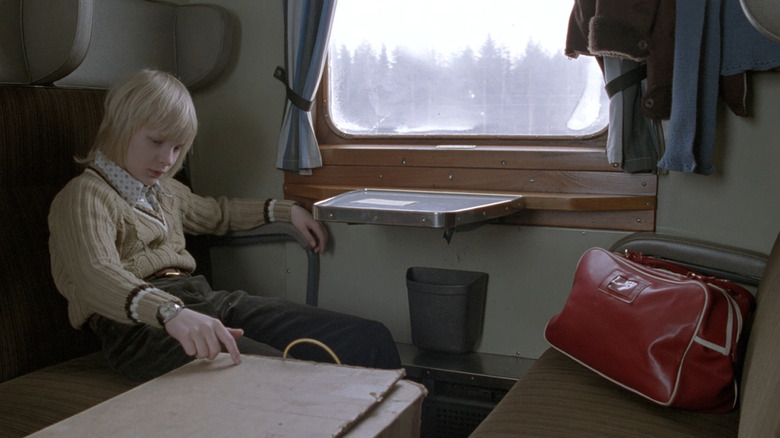
“Let the Right One In” climaxes with a mutual act of violent commitment from Oskar and Eli. First, Oskar saves Eli’s life when Lacke (Peter Carlsberg) breaks into her apartment and prepares to kill her while she sleeps. Oskar is on hand to distract him, giving Eli a chance to wake up and finish off her would-be slayer.
Lacke’s violent death disturbs the neighbors and Eli decides she must move on, leaving Oskar behind. The next day, the school bullies lure Oskar to a swimming session at the local baths, seeking revenge for hitting back at gang leader Conny (Patrik Rydmark) earlier in the movie. With Conny’s nasty big brother Jimmy (Rasmus Luthander) as extra muscle, they set a fire to distract the teacher and scare off the other kids. Now Oskar is alone facing four of them and Jimmy forces his head under the water. It really looks like he intends to drown the boy until Eli swoops in unseen to wreak carnage on the bullies, beheading one and ripping Jimmy’s arm off.
The film ends in a train carriage. Oskar has a large box with him, and a knocking sound comes from within. In morse code, Eli taps out the word “kiss,” and Oskar responds with “small kiss.” The future looks grim as they are now on the run after several murders in Blackeburg; Sweden is a fairly small country, so how long can they expect to stay ahead of the authorities? For Oskar’s sake, it might be best if they get picked up at the next station, as Håkan’s lonely fate is a strong indication of where he is headed. But for now, in this quiet moment sending kisses, they have each other.
Read this next: The 95 Best Horror Movies Ever
The post Let the Right One In Ending Explained: A Tale of Boy Meets Vampire appeared first on /Film.
[ad_2]
Source link

